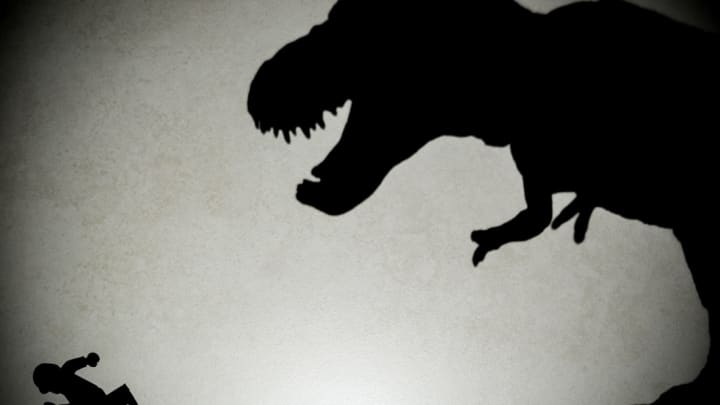Is It True That T. Rex Could Only See Things That Were Moving?
By Matt Soniak

I rewatched Jurassic Park a few weeks ago and, from the story to the special effects, it still holds up. But I’ve been nagged by one thing that’s stuck with me from the first time I saw the movie—a thing that has been ingrained in our collective knowledge and perception of dinosaurs: protagonist Alan Grant's assertion about what the Tyrannosaurus rex can and can’t see.
In the scene where the T. rex gets loose and attacks a group of human characters, Grant says to Lex, “Don’t move. It can’t see us if we don’t move.” Sure enough, the dinosaur gets up in their faces without noticing them right after he says that. For what it's worth, Michael Crichton does explain in the Jurassic Park novel that the amphibian DNA used to help bring the dinosaurs to life hobbled their visual cortices. Director Steven Spielberg and the movie's screenwriters dropped the ball big time here, importing the dinosaurs’ vision problems but not the explanation for them. Instead, in the movie, Grant comes off like he’s stating an accepted dino fact.
Sci-Fi versus Reality
He’s not. In the last few years, real-world paleontologists have proven Dr. Grant very wrong. In 2006, Kent Stevens from the University of Oregon did an experiment inspired by that very scene to figure out what sort of binocular range (the field of view both eyes can see simultaneously) T. rex might have had. The wider that range, the better an animal’s depth perception and capacity to distinguish objects that are motionless or camouflaged.
Stevens built a scale model of the T. rex’s head and popped in some taxidermic eyes based on the eyes of three animals pretty closely related to T. rex—alligators, ostriches, and eagles—and adapted for situations that a dinosaur would have likely encountered. As he explains on his website, he used a technique called “inverse perimetry” to estimate “whether a given probe would be visible, based on whether there is a clear, unobstructed view of the pupil along a line of sight,” and mapped the model’s field of view.
Stevens' model study suggests that T. rex had a binocular range of around 55°, better than that of modern-day hawks and eagles. And it would have only gotten better. Paleontologists know from the fossil record that, over millennia, T. rex’s eyes got larger and its snout got lower and narrower, giving it even clearer sight lines than Stevens’ model.
For more on dino-vision, see Stevens' web page and the study. For more on other JP mistakes that make dino geeks fume, see this Wikipedia list.